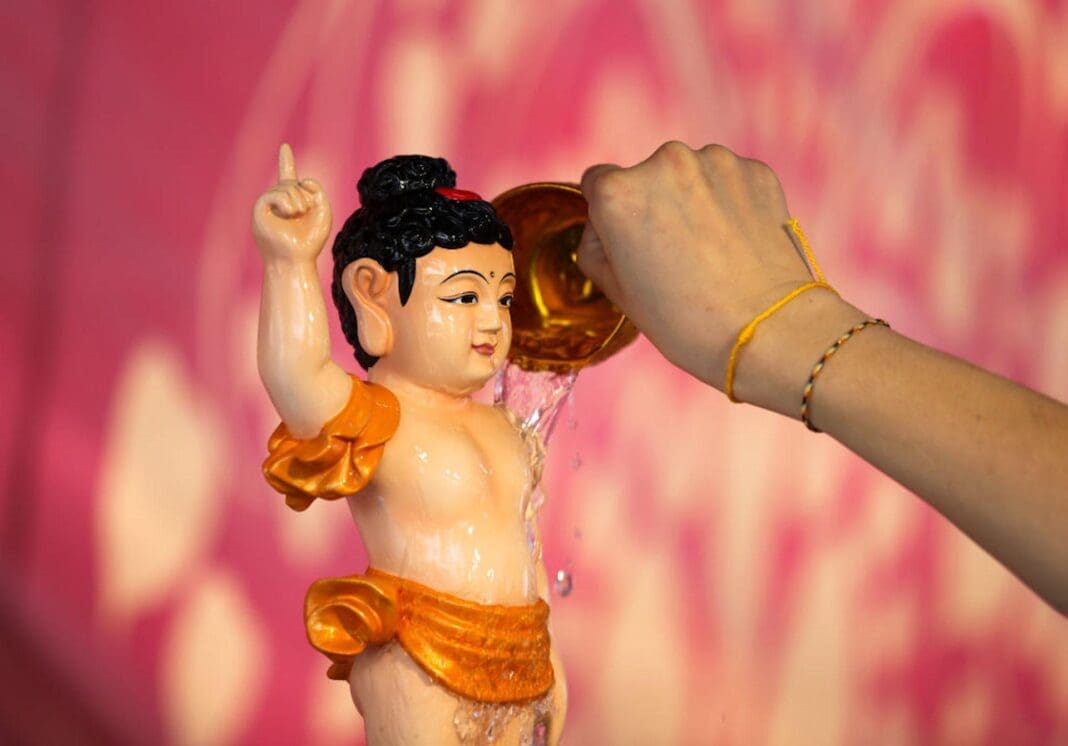When Siddhartha Gautama was born, he was clearly no ordinary infant. According to Buddhist texts, he raised his hand to the skies and declared, “In the heavens above and below the heavens, I am the world’s most honored one. I will free all beings from birth, old age, sickness, and death.”
Then the remarkable baby is believed to have received a first bath: streams of water poured by the gods Brahma and Indra – or flowing from two dragon kings’ mouths, depending on the legend. This cleansing consecrated the Buddha-to-be as holy, signaling that even the gods recognized him as worthy of veneration.
Buddhists believe that several “buddhas,” or enlightened teachers, have been born throughout history. Yet the title “the Buddha” typically refers to this historical figure, Siddhartha Gautama, who went on to found Buddhism. Each year on the Buddha’s birthday, East Asian Buddhists recreate his first bath by pouring water or sweetened tea over a statue of the infant.
The holiday has been observed in different parts of Asia for hundreds of years, but its significance varied by region. In Sri Lanka, for example, it was a religious day simply celebrated at temples, not a public celebration. In Korea, on the other hand, the Buddha’s birthday became a more commercial festival under the Choson dynasty, which frowned upon Buddhist religious practices and ended in 1910.
Buddhist reformers in the 19th and 20th centuries, however, deliberately emphasized the Buddha’s birthday in their efforts to unite Buddhist populations across countries and protect traditions from Christian missionaries. In the late 1800s, Sri Lankans successfully petitioned the British colonial government to allow celebrations for the Buddha’s birthday, which they deliberately modeled on Christmas – a model that caught on around Asia.
These efforts helped the Buddha’s birthday become a major global holiday, but celebrations still take place on different dates and with different traditions. As a scholar of Buddhism who studies the religion’s transmission from India to China, I am keenly aware of how people adapt practices and ideas to their own cultures.
In South Asia and Southeast Asia, the Buddha’s birthday is celebrated on the full moon of the second lunar month, known as Vesākha or Vaiśākha. In Sanskrit, a full moon is “Pūrṇimā,” which is why the holiday is often called Buddha Pūrṇimā, Vesak or Wesak.
Vaiśākha corresponds to April and May of the Gregorian calendar, so in 2023, people in countries like Sri Lanka, Cambodia, Laos and Burma celebrated the Buddha’s birthday on the full moon of May 5.
Buddhists in East Asia, however, mark the Buddha’s birthday on the eighth day of the fourth lunar month – and follow a different lunisolar calendar, too. In China, Vietnam and Korea, Buddha’s birthday will be celebrated in 2023 on May 26.
But there are even more variations. The Taiwanese government decided in 1999 to celebrate the Buddha’s birthday jointly with Mother’s Day, on the second Sunday in May. In Japan, meanwhile, the Buddha’s birthday is called “Flower Festival” – Hana Matsuri in Japanese – and celebrated on April 8, following the government’s decision to adopt the Gregorian calendar in 1873.
Yet another date for the Buddha’s birthday in 2023 is June 4: the full moon of the fourth lunar month in the Tibetan lunisolar calendar. The entire month, called Saga Dawa, is considered holy because it includes the Buddha’s birth, awakening and death. Tibetan Buddhists believe that good deeds generate exponentially more positive karma during Saga Dawa than at other times of the year.
The date of the Buddha’s birthday isn’t the only difference between cultures. In South Asia and Southeast Asia, including Tibetan regions, Vesak doesn’t just commemorate the Buddha’s birth, but also his attainment of nirvāṇa, or enlightenment, and his death, known as parinirvana. In East Asia, however, the Buddha’s enlightenment and passing are honored on separate days, so the spring holiday only focuses on the Buddha’s birth.
Throughout East Asia, Buddhists will bathe statues of the infant Buddha-to-be, recite Buddhist scriptures and make donations to Buddhist temples – but there will still be a lot of diversity in these celebrations.
In China, the practice of “fangsheng,” releasing animals, has been part of celebrating the Buddha’s birthday since the 11th century. Devout Buddhists purchase animals otherwise destined for slaughter and release them into the wild. Recently, some cities in China have encouraged greater consideration of local ecosystems to prevent invasive species that worshippers release from crowding out native animals.
Another way Chinese Buddhists express compassion for all living beings is by avoiding meat for three days around the Buddha’s birthday – similar to the Tibetan practice of following a vegetarian diet during the month of Saga Dawa.
Korea was under Japanese imperial rule from 1910 to 1945. During that period, the Japanese government sponsored a joint Japanese-Korean celebration of the Buddha’s birthday that revived the holiday’s religious significance. Though many Koreans opposed the Japanese occupation, some Korean Buddhists appreciated the opportunity to celebrate the Buddha’s birthday as a new pan-Buddhist holiday.
Korean celebrations of the Buddha’s birthday are distinctive for their use of lanterns, which represent the light of awakening and can also be used as vehicles for prayers and vows sent up toward the heavens. Today in South Korea, colorful lantern displays and lantern parades mark the national holiday.
The Buddha’s birthday has even been observed in North Korea since 1988, despite the country’s general suppression of religious activity. In 2018, the holiday served as an occasion for Korean unity, with Buddhists in North and South Korea jointly composing and reciting a prayer for the occasion.
In Vietnam, the celebration of the Buddha’s birthday – known as Phật Đản – was observed in the medieval period, often alongside prayers for rain. However, celebrations seem to have faded over time until the festival was reintroduced in the early 20th century, when the holiday was gaining popularity throughout the region.
The holiday still remains somewhat obscure in northern Vietnamese villages, but has gained popularity elsewhere in the country. Today, Buddha birthday celebrations in Vietnam involve lighting paper lanterns, making offerings to the Buddha and praying for health and well-being. Lotus-shaped lanterns are especially popular because they symbolize the ability to remain pure in an impure world, just like beautiful lotuses grow from murky swamps.
Buddha birthday celebrations that fall earlier in the spring are often the ones international groups focus on. In 1950, the World Fellowship of Buddhists decided to make Vesak an international Buddhist holiday, commemorated on the first full moon of May. Nearly 50 years later, the United Nations passed a resolution to recognize Vesak on the same day, in line with South Asian and Southeast Asian celebrations.
These official acts of recognition mark the importance of this holiday for Buddhists worldwide, but we should also remember the just-as-meaningful celebrations that come a few weeks later.
This article is republished from The Conversation, an independent nonprofit news site dedicated to sharing ideas from academic experts. The Conversation has a variety of fascinating free newsletters.
Read more: Why so many Americans think Buddhism is just a philosophy How to know if your practice of Buddhism through listening to podcasts or use of meditation apps is ‘authentic’
Megan Bryson does not work for, consult, own shares in or receive funding from any company or organization that would benefit from this article, and has disclosed no relevant affiliations beyond their academic appointment.














